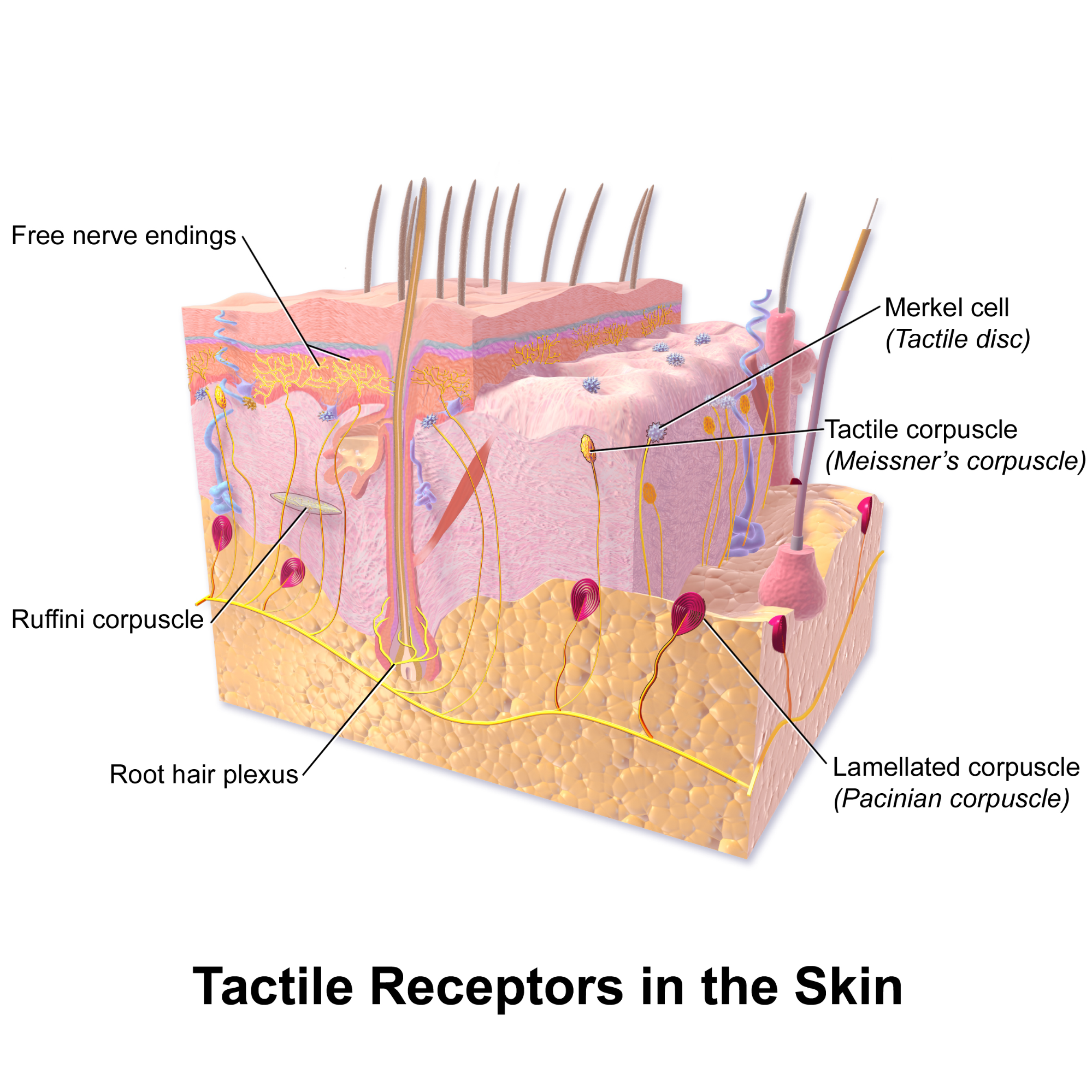Somatosensation
3
Learning Objectives
Knows the four types of mechanoreceptors in the skin.
Know what role the two corpuscles and two nerve endings play in the skin.
Know the different rates of adaptation in cutaneous mechanoreceptors.

In glabrous (hairless) skin, there are four principal types of mechanoreceptors, each shaped according to its function (Fig.2.3.1). The tactile corpuscles (also known as Meissner corpuscles) respond to light touch and adapt rapidly to changes in texture (vibrations around 50 Hz). The bulbous corpuscles (also known as Ruffini endings) detect tension deep in the skin and fascia. The Merkel nerve endings (also known as Merkel discs) detect sustained pressure. The lamellar corpuscles (also known as Pacinian corpuscles) in the skin and fascia detect rapid vibrations (of about 200–300 Hz).
Cutaneous mechanoreceptors respond to mechanical stimuli that result from physical interaction, including pressure and vibration. They are located in the skin, like other cutaneous receptors. They are all innervated by Aβ fibers, except the mechanorecepting free nerve endings, which are innervated by Aδ fibers. Cutaneous mechanoreceptors can be categorized by morphology, by what kind of sensation they perceive, and by the rate of adaptation. Furthermore, each has a different receptive field.
- The Slowly Adapting type 1 (SA1) mechanoreceptor, with the Merkel corpuscle end-organ, underlies the perception of form and roughness on the skin.[1] They have small receptive fields and produce sustained responses to static stimulation.
- The Slowly Adapting type 2 (SA2) mechanoreceptors, with the Ruffini corpuscle end-organ, respond to skin stretch, but have not been closely linked to either proprioceptive or mechanoreceptive roles in perception.[2] They also produce sustained responses to static stimulation, but have large receptive fields.
- The Rapidly Adapting (RA) or Meissner corpuscle end-organ mechanoreceptor underlies the perception of flutter[3] and slip on the skin.[4] They have small receptive fields and produce transient responses to the onset and offset of stimulation.
- The Pacinian corpuscle or Vater-Pacinian corpuscles or Lamellar corpuscles [5] underlie the perception of high frequency vibration.[3] [6] They also produce transient responses, but have large receptive fields.
Here is a quick five minute video also linked here which covers the four different kinds of mechanoreceptors:
CC LICENSED CONTENT, SHARED PREVIOUSLY
Wikipedia, Mechanoreceptor
URL: https://en.wikipedia.org/wiki/Mechanoreceptor#Types
License: CC BY SA 4.0
Blausen.com staff (2014). “Medical gallery of Blausen Medical 2014.” staff (2014). WikiJournal of Medicine 1 (2). DOI:10.15347/wjm/2014.010. ISSN 2002-4436. – Own work, CC BY 3.0, https://commons.wikimedia.org/w/index.php?curid=30871451
References:
[1] Johnson KO, Hsiao SS (1992). “Neural mechanisms of tactual form and texture perception”. Annual Review of Neuroscience. 15: 227–50. doi:10.1146/annurev.ne.15.030192.001303. PMID 1575442.
[2] ^ Torebjörk HE, Ochoa JL (December 1980). “Specific sensations evoked by activity in single identified sensory units in man”. Acta Physiologica Scandinavica. 110 (4): 445–7. doi:10.1111/j.1748-1716.1980.tb06695.x. PMID 7234450.
[3]a b Talbot WH, Darian-Smith I, Kornhuber HH, Mountcastle VB (March 1968). “The sense of flutter-vibration: comparison of the human capacity with response patterns of mechanoreceptive afferents from the monkey hand”. Journal of Neurophysiology. 31 (2): 301–34. doi:10.1152/jn.1968.31.2.301. PMID 4972033.
[4]^ Johansson RS, Westling G (1987). “Signals in tactile afferents from the fingers eliciting adaptive motor responses during precision grip”. Experimental Brain Research. 66 (1): 141–54. doi:10.1007/bf00236210. PMID 3582528.
[5]^ Biswas A, Manivannan M, Srinivasan MA (2015). “Multiscale layered biomechanical model of the pacinian corpuscle”. IEEE Transactions on Haptics. 8 (1): 31–42. doi:10.1109/TOH.2014.2369416. PMID 25398182.
[6]^ Biswas A, Manivannan M, Srinivasan MA (2015). “Vibrotactile sensitivity threshold: nonlinear stochastic mechanotransduction model of the Pacinian Corpuscle”. IEEE Transactions on Haptics. 8 (1): 102–13. doi:10.1109/TOH.2014.2369422. PMID 25398183.

